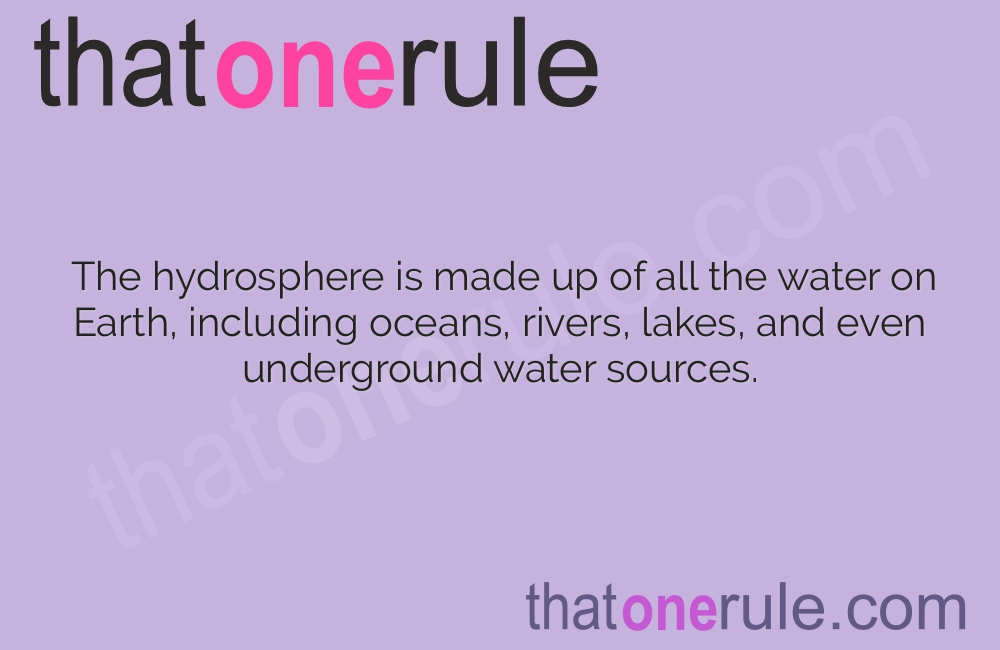

The hydrosphere is made up of all the water on Earth, including oceans, rivers, lakes, and even underground water sources.
The hydrosphere is made up of all the water on Earth, including oceans, rivers, lakes, and even underground water sources.
Approximately 97% of Earth’s water is found in the oceans.
The remaining 3% is fresh water, most of which is stored in glaciers and ice caps.
The hydrosphere plays a crucial role in regulating the Earth’s climate and temperature.
The oceans absorb and store huge amounts of carbon dioxide, helping to mitigate climate change.
Water covers about 71% of Earth’s surface, earning it the nickname the blue planet.
The Pacific Ocean is the largest and deepest ocean on Earth.
The Mariana Trench in the Pacific Ocean is the deepest point on Earth, reaching a depth of about 36,070 feet (10,994 meters).
The hydrosphere is home to an estimated 230,000 known species, with many more yet to be discovered.
Coral reefs, found in tropical oceans, are incredibly diverse ecosystems and provide a habitat for numerous marine species.
The Great Barrier Reef in Australia is the largest coral reef system in the world, stretching over 1,430 miles (2,300 kilometers).
The hydrosphere is essential for human survival, as we rely on water for drinking, agriculture, transportation, and many other purposes.
The water cycle is the continuous movement of water on, above, and below the Earth’s surface, driven by energy from the sun.
Evaporation is the process by which water changes from a liquid to a gas, typically from the surface of oceans and lakes.
Condensation is the opposite process of evaporation, where water vapor turns back into liquid form, forming clouds.
Precipitation occurs when condensed water vapor falls from the atmosphere in the form of rain, snow, sleet, or hail.
The polar ice caps are significant contributors to the hydrosphere, holding vast amounts of freshwater.
The melting of polar ice caps due to global warming is causing sea levels to rise, threatening coastal regions around the world.
The hydrosphere is interconnected with other Earth systems, such as the atmosphere and biosphere, creating a complex web of interactions.
Ocean currents play a crucial role in distributing heat around the planet, affecting climate patterns.
The Gulf Stream, a powerful warm ocean current, helps to moderate temperatures in Western Europe.
The hydrosphere is a vast reservoir of resources, including fish, minerals, and energy sources such as oil and gas.
Overfishing is a significant threat to the health and balance of marine ecosystems.
Pollution, including plastic waste, chemicals, and oil spills, poses a severe threat to the hydrosphere and the organisms that inhabit it.
The Dead Sea, located between Israel and Jordan, is the saltiest body of water on Earth and has a salinity level that makes floating effortless.
Water is unique in that it expands when it freezes, which is why ice floats on water.
The hydrosphere plays a critical role in erosion, shaping the Earth’s landscape through processes such as rivers carving out canyons and waterfalls.
Water scarcity affects nearly 1.2 billion people worldwide, highlighting the importance of preserving and conserving water resources.
The hydrosphere has fascinating geological features, such as underwater volcanoes and hydrothermal vents, which support diverse ecosystems.
The Dead Sea Scrolls, ancient Jewish manuscripts discovered in the mid-20th century, were found in caves near the Dead Sea.
The hydrologic cycle is essential for maintaining a stable supply of freshwater on Earth.
Estuaries, where rivers meet the ocean, are incredibly productive ecosystems that serve as nurseries for many marine species.
The Salton Sea in California is the largest inland body of water in the state and was accidentally formed in 1905 when the Colorado River flooded into the area.
Water is a universal solvent, meaning it can dissolve various substances, making it an essential medium for chemical reactions and vital for life.
The ocean’s deep-sea trenches are home to fascinating and often bizarre creatures adapted to extreme pressure and darkness.
Desalination is the process of removing salt and other minerals from seawater, making it suitable for human consumption.
The Caspian Sea, located between Europe and Asia, is the largest enclosed inland body of water on Earth.
Tsunamis, giant ocean waves primarily caused by earthquakes, can wreak havoc on coastal regions.
The hydrosphere is a vast storage unit for heat energy, helping to regulate Earth’s climate by absorbing and releasing heat slowly.
The Aral Sea, once the world’s fourth-largest lake, has dramatically shrunk due to human water extraction, leading to ecological and economic devastation in the surrounding regions.
Water has a high surface tension, which allows some small organisms like water striders to walk on its surface.
Earth’s water is constantly recycled through processes such as evaporation, transpiration, and precipitation, ensuring a continuous supply.
Some organisms, like the tardigrade or water bear, can survive extreme conditions, including being frozen or dried out, demonstrating the resilience of life in the hydrosphere.
Water regulates temperature through its high specific heat capacity, helping to moderate climate extremes and maintain stable conditions for life.
The hydrosphere is a source of inspiration and wonder, offering an endless array of picturesque landscapes, from serene lakes to majestic waterfalls and vibrant coral reefs.
Around the world, coffee enthusiasts enjoy Monin coffee concentrate since it is a multipurpose product. Conveniently combining…
The Importance of Choosing the Right Shower for Your Bathroom Renovating your bathroom can be…
Usain Bolt holds the record for the fastest 100-meter sprint in history.Bolt was named Sportsman…
Love is in the air... and it smells suspiciously like chocolate!Roses are red, violets are…
Life's a beach, take a picture and relax.Sun, sand, and salty kisses. That's what beach…
Hungary is home to the largest thermal water cave system in the world.The Rubik's Cube…